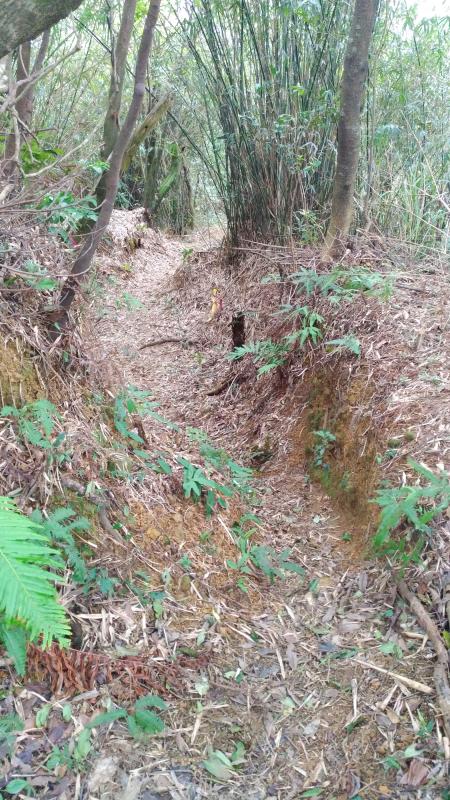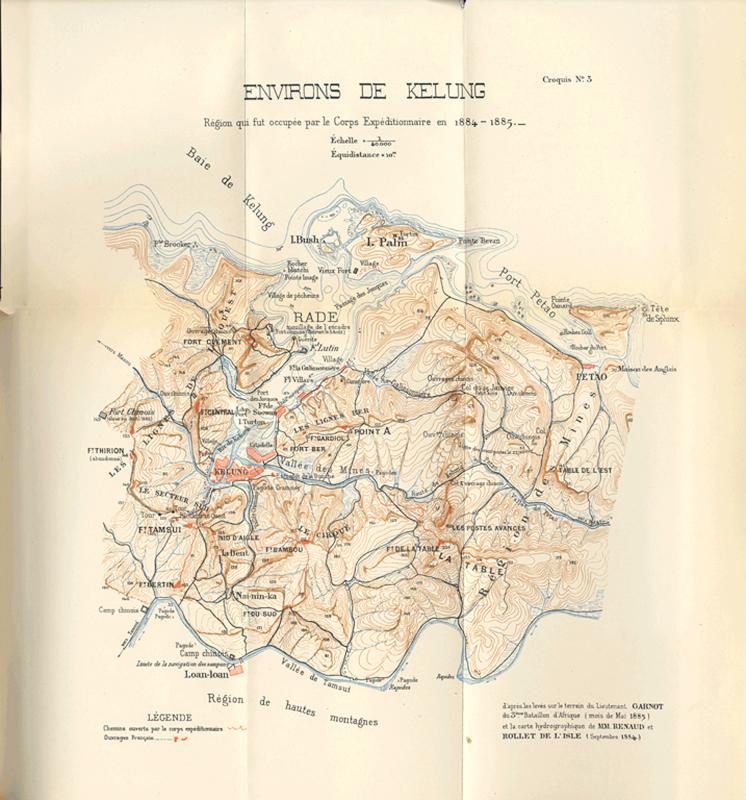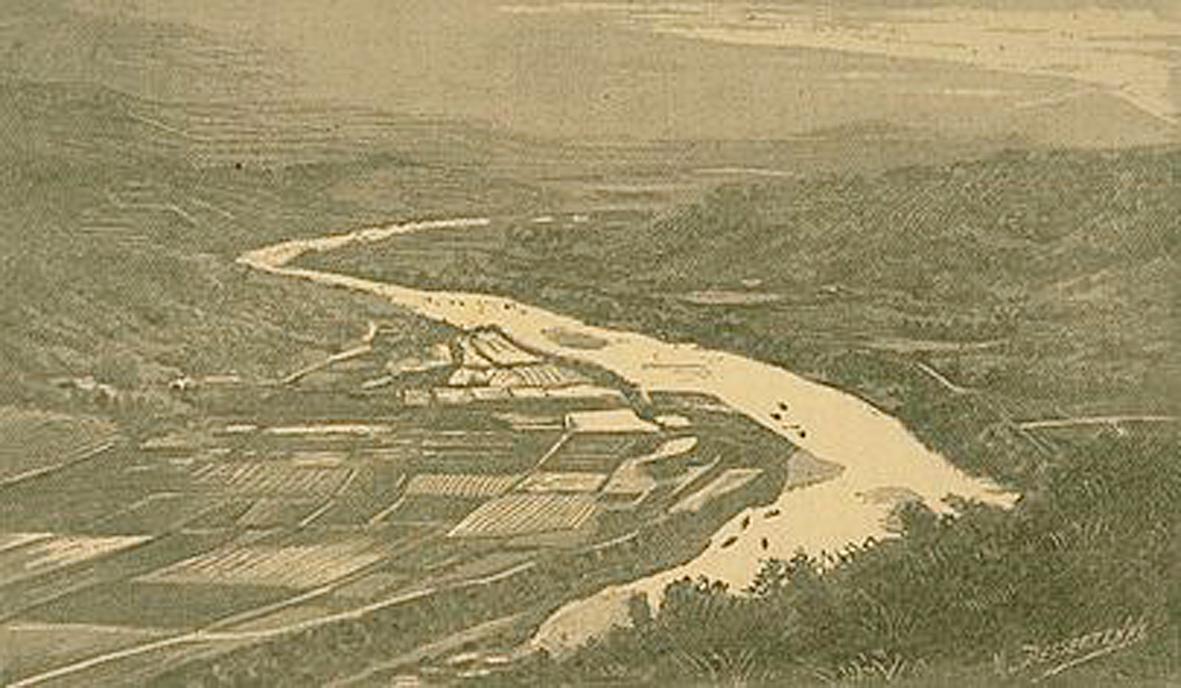The Witnessed Account of British Resident: John Dodd at Tamsui is a book essentially built around the diary of the British tea merchant and the hardships he faced as a result of a blockade by French forces taking part in the wider Sino-French War of the mid-1880s.
A valuable record of the period, to any history buff it is just as valuable for the numerous French military maps included at the front of the book — many showing forts in and around the Keelung area that no longer appear on contemporary versions.
And as a “self-titled” history buff, and former military guy myself, when one day comparing the French maps of old with locally produced tourist maps of today, my own interest was piqued as to why so many sites of obvious historical importance were now missing.

Photo: Mark Buckton
Months of digging and many visits to Keelung later, I realised that none of the forts that are maintained today as tourist sights in the city actually featured directly in the so-called Keelung Campaign undertaken by French forces.
Further research led to a Chinese language blog detailing a Fort Bertin — and only Fort Bertin — as “location unknown.” The rest had been built over, or were still relatively easy to find with a bit of effort.
So, armed with a map well over a century old I headed into the hills in the area I thought Fort Bertin “should” be located.

Photo courtesy of Wikimedia Commons
KEELUNG CAMPAIGN
When 27 year-old Captain Simon Roger Bertin and a force of 2,000 French troops arrived in Keelung in October 1884, he likely had no idea his name would live on in the town so long after he would leave.
He was a small cog in an effort to secure coal supplies to help French efforts in their ongoing conflict against Qing Dynasty forces in what is now northern Vietnam.

Photo courtesy of Wikimedia Commons
Now known as the Keelung Campaign, part of the Sino-French War, soon after his arrival, as the officer commanding the 26th Company of the 3rd Battalion, 2nd Marine Infantry Regiment, Bertin and his compatriots were enjoying early success.
Local forces loyal to the Qing were not prepared for the artillery onslaught they would face, and just days after arriving, the French Tricolor was flying above several hastily built fortifications overlooking the town.
A front line saw forts named Clement, Central and Thirion dominate the western hills of Keelung while another outpost, Fort Tamsui, was also built protecting the southern approach to the town.
Counter-attacks by Qing troops on Nov. 2 1884, proved ineffective, so men under Qing Dynasty governor, Liu Mingchuan (劉銘傳), started to establish their own fortifications on nearby peaks.
Records indicate that one of these fortifications sat atop a hill named Shiqiuling (獅球嶺); a position attacked by French troops on Dec. 12.
Despite taking Shiqiuling, with ranks depleted due to sickness the French had to withdraw. Qing soldiers soon returned and rebuilt.
Around the same time, Qing forces also started to fortify a strategic ridge to the south of Fort Tamsui. Firing positions, and walls atop deep trenches were built facing the French.
The Qing were ready for a frontal French assault, which never materialized.
Instead, on March 4, 1885, French forces outflanked Qing positions, and over four days captured hilltops above today’s Nuannuan District (暖暖), in the process killing 1,500 Qing soldiers at a reported cost of 41 French dead and 157 wounded.
This flanking action left Shiqiuling and the unnamed ridge severely exposed.
Observing the overwhelming French successes, Qing troops at Shiqiuling and on the ridge abandoned their positions and melted away.
As a result, on March 9th, when Captain Bertin and his troops moved on Shiqiuling, they found it deserted.
Soon after, the French took the fortified ridge, and in the process moved as far inland as they would ever get.
Following rudimentary improvements to the fortifications, the ridge subsequently became known as Fort Bertin following the French custom of naming positions after commanding officers.
BERTIN LEAVES TAIWAN
Several weeks later orders were issued recalling Bertin to France, and on March 31st, Captain Simon Roger Bertin left Keelung.
It is unlikely he ever returned.
A year later he was posted to Africa, before going on to enjoy a distinguished career, reaching the rank of brigadier general before dying in 1943.
For acts of bravery during his service in Taiwan he was presented with the Legion d’honneur — France’s highest order of merit — and the fortifications carrying his name were finished off by fellow officer Joseph Joffre, himself a future commander-in-chief of French forces during World War I.
And just three months later French troops lowered their colors over Keelung for the last time, and departed Taiwan.
Fort Bertin was abandoned once more.
In time memories of the Keelung Campaign, and Fort Bertin faded.
FORT REDISCOVERED
Late last year, however, Fort Bertin was “rediscovered” — by yours truly — overgrown for the most part and in need of restoration before what is left is reclaimed by Mother Nature forever.
Located for almost 140 years overlooking the train line to Taipei, and now the approach of Highway 1 into Keelung, the remains of walls, trenches and firing positions are still identifiable to the trained eye. Indeed, I fell into, or slid down the side of several of these trenches in taking the photos for this piece.
More than once I had to undress at my door when I arrived home so as not to carry mud into the house.
On one occasion I had to fend off dogs obviously unaccustomed to seeing humans in the area.
A stone carrying the mark of Houtu, the Queen of the Earth Land Goddess, is easily missed on the edge of a large trench near the corner point of the ridge. This point is still being investigated.
What happens next, however, in the story of Captain Bertin, his men and the Qing soldiers who established this now historical but forgotten site is up to Keelung’s Cultural Affairs Bureau.
Local staff charged with protecting city assets have proven more than interested in the find, but have been delayed in visiting the site by the seasonal rains Keelung is so well known for.
When the weather abates, at least one member of the office, Max Liu (劉秉竑) of the Cultural Assets Section, as point of contact on Fort Bertin will visit the site.
Decisions will then follow as to what happens at the site, if it is excavated, maintained thereafter perhaps, and if the memory of the men who manned its trenches and firing positions almost 140 years ago is this time remembered.

The Taipei Times last week reported that the rising share of seniors in the population is reshaping the nation’s housing markets. According to data from the Ministry of the Interior, about 850,000 residences were occupied by elderly people in the first quarter, including 655,000 that housed only one resident. H&B Realty chief researcher Jessica Hsu (徐佳馨), quoted in the article, said that there is rising demand for elderly-friendly housing, including units with elevators, barrier-free layouts and proximity to healthcare services. Hsu and others cited in the article highlighted the changing family residential dynamics, as children no longer live with parents,

The classic warmth of a good old-fashioned izakaya beckons you in, all cozy nooks and dark wood finishes, as tables order a third round and waiters sling tapas-sized bites and assorted — sometimes unidentifiable — skewered meats. But there’s a romantic hush about this Ximending (西門町) hotspot, with cocktails savored, plating elegant and never rushed and daters and diners lit by candlelight and chandelier. Each chair is mismatched and the assorted tables appear to be the fanciest picks from a nearby flea market. A naked sewing mannequin stands in a dimly lit corner, adorned with antique mirrors and draped foliage

The election of Cheng Li-wun (鄭麗文) as chair of the Chinese Nationalist Party (KMT) marked a triumphant return of pride in the “Chinese” in the party name. Cheng wants Taiwanese to be proud to call themselves Chinese again. The unambiguous winner was a return to the KMT ideology that formed in the early 2000s under then chairman Lien Chan (連戰) and president Ma Ying-jeou (馬英九) put into practice as far as he could, until ultimately thwarted by hundreds of thousands of protestors thronging the streets in what became known as the Sunflower movement in 2014. Cheng is an unambiguous Chinese ethnonationalist,

I was 10 when I read an article in the local paper about the Air Guitar World Championships, which take place every year in my home town of Oulu, Finland. My parents had helped out at the very first contest back in 1996 — my mum gave out fliers, my dad sorted the music. Since then, national championships have been held all across the world, with the winners assembling in Oulu every summer. At the time, I asked my parents if I could compete. At first they were hesitant; the event was in a bar, and there would be a lot